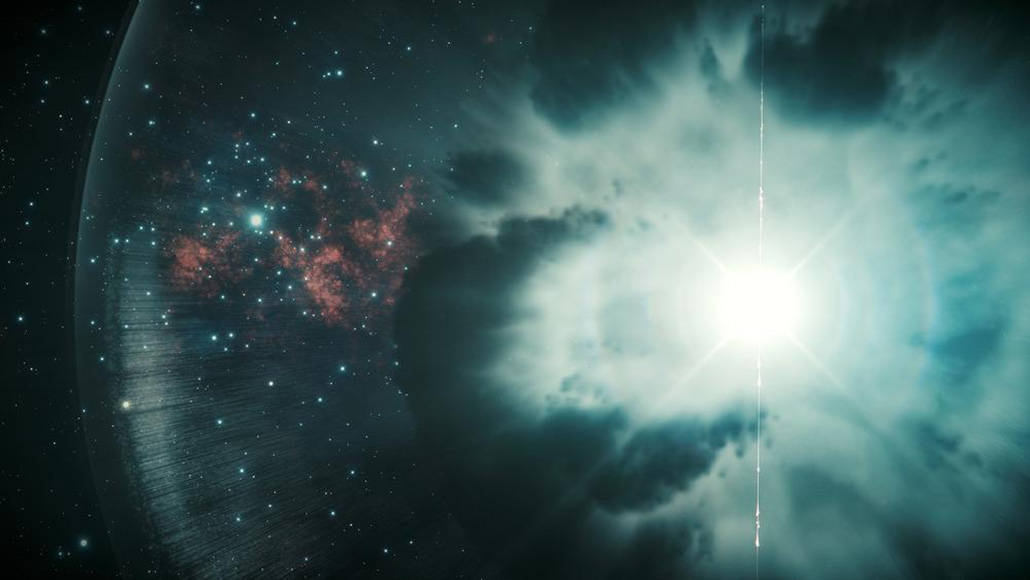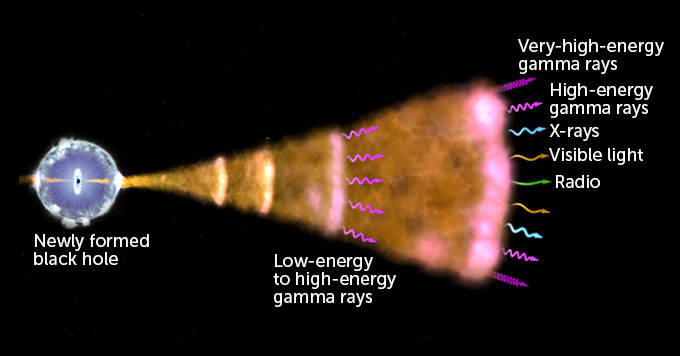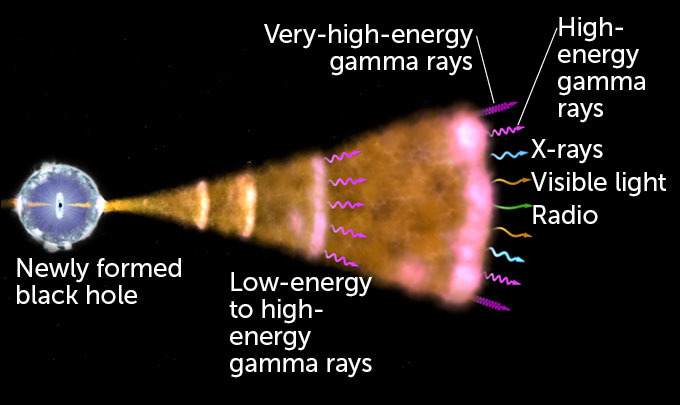
The explosion of a star can trigger a gamma-ray burst (illustrated). Speedy electrons trapped in magnetic fields produce energetic light from these bursts, new research shows.
Science Communication Lab/DESY
Two eruptions of gamma rays from exploding stars in far-off galaxies have pelted Earth with the highest-energy photons yet detected from one of these explosions. The shower of light particles reveals how so-called long gamma-ray bursts — among the most powerful explosions in the universe — produce such energetic photons.
“This is the Rosetta Stone of gamma-ray bursts,” says Tsvi Piran, an astrophysicist at the Hebrew University of Jerusalem who was not involved with this research.
Long gamma-ray bursts, or GRBs, mark the death of a massive star as it explodes and leaves behind a neutron star or a black hole. (Short GRBs, on the other hand, accompany collisions between neutron stars, such as the smashup picked up by gravitational-wave detectors in 2017 (SN: 10/16/17).) Until now, the most energetic photons radiating from a long GRB typically maxed out at a few million electron volts of energy, or roughly a million times more energetic than the photons our eyes detect.
That record has been smashed. In July 2018 the HESS observatory, about 100 kilometers southwest from the Namibian capital of Windhoek, recorded photons from a GRB with between 100 billion and 440 billion electron volts, 10 hours after the initial burst. Six months later, in January 2019, the twin MAGIC telescopes in the Canary Island of La Palma saw a different burst and captured photons with a whopping 1 trillion electron volts of energy. The previous record holder from a GRB was a single photon with 94 billion electron volts, detected from a gamma-ray burst in 2013 (SN: 11/21/13). The new findings appear in three papers published November 20 in Nature.

“There were theories predicting that there should be [very-high-energy photons] from GRBs, but things were very uncertain,” says Razmik Mirzoyan, an astrophysicist at the Max Planck Institute for Physics in Munich who led the study of the 2019 burst. These theories offered differing explanations for how magnetic fields, electrons and ambient light interacted within the debris from a GRB explosion to produce gamma rays. To test these ideas, several teams have been hunting for very-high-energy gamma rays for years, says Mirzoyan. “We were trying for 15 years, but never succeeding.”
Their newfound success reveals a tale of how GRB photons get so much vigor. Shock waves from the explosion accelerate electrons to nearly the speed of light and generate magnetic fields. The electrons whip around the magnetic field lines and emit relatively low-energy photons. These photons, along with other photons passing by from other galaxies, subsequently get a power boost by ricocheting off and stealing energy from these speedy electrons. It’s this last step, known as inverse Compton scattering, that gives some GRB photons their extreme energies.
“This basic theory came out more than 20 years ago, but there was no proof,” Piran says. “It’s so wonderful that they got it.”
The discovery was helped by the relative proximity of the two blasts. The light from the 2018 burst took about 6 billion years to reach Earth; the 2019 explosion needed roughly 4.5 billion years. While that puts both bursts far beyond our galactic neighborhood, they were much closer than typical GRBs.
The extreme photons revealed a couple of tidbits about GRBs. For inverse Compton scattering to work, the low-energy photons need good odds of running into electrons. “This tells you that you have a very dense medium” around the explosion, says Edna Ruiz-Velasco, an astrophysicist at the Max Planck Institute for Nuclear Physics in Heidelberg, Germany, who studied the 2018 burst.
It also appears that astronomers have been underselling just how much oomph a GRB can pack. GRBs emit light across the entire electromagnetic spectrum — from radio waves to gamma rays — and the 2019 burst pumped as much energy into its extreme gamma-ray photons as it did into its more numerous X-rays, Mirzoyan says. That bumps up the overall energy for GRBs — already comparable to the entire energy output of the sun over its lifetime — by about one-third, he says.









